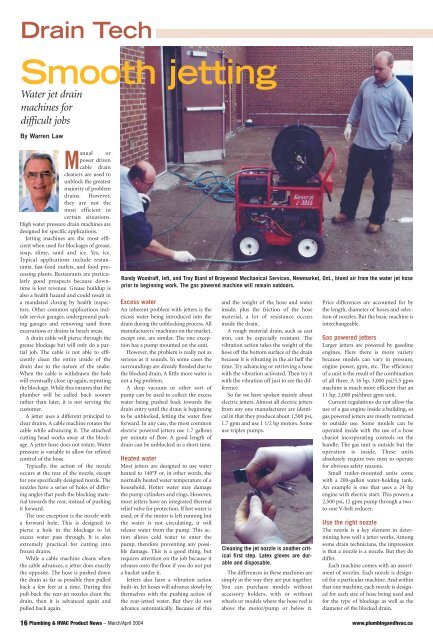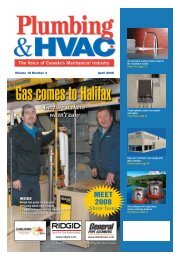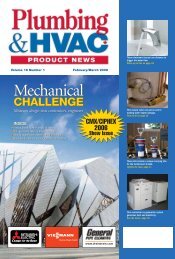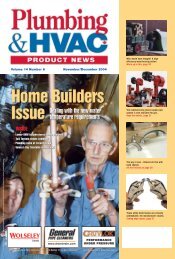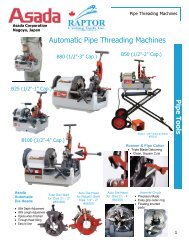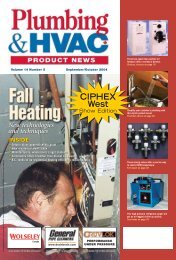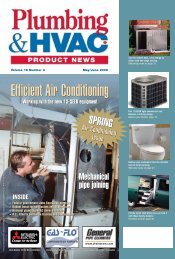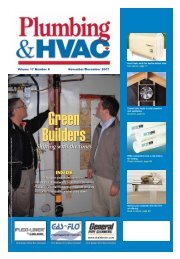CMX 2004 - Plumbing & HVAC
CMX 2004 - Plumbing & HVAC
CMX 2004 - Plumbing & HVAC
Create successful ePaper yourself
Turn your PDF publications into a flip-book with our unique Google optimized e-Paper software.
Drain Tech<br />
Smooth jetting<br />
Water jet drain<br />
machines for<br />
difficult jobs<br />
By Warren Law<br />
Manual or<br />
power driven<br />
cable drain<br />
cleaners are used to<br />
unblock the greatest<br />
majority of problem<br />
drains. However,<br />
they are not the<br />
most efficient in<br />
certain situations.<br />
High water pressure drain machines are<br />
designed for specific applications.<br />
Jetting machines are the most efficient<br />
when used for blockages of grease,<br />
soap, slime, sand and ice. Yes, ice.<br />
Typical applications include restaurants,<br />
fast-food outlets, and food processing<br />
plants. Restaurants are particularly<br />
good prospects because downtime<br />
is lost revenue. Grease buildup is<br />
also a health hazard and could result in<br />
a mandated closing by health inspectors.<br />
Other common applications include<br />
service garages, underground parking<br />
garages and removing sand from<br />
excavations or drains in beach areas.<br />
A drain cable will pierce through the<br />
grease blockage but will only do a partial<br />
job. The cable is not able to efficiently<br />
clean the entire inside of the<br />
drain due to the nature of the snake.<br />
When the cable is withdrawn the hole<br />
will eventually close up again, repeating<br />
the blockage. While this ensures that the<br />
plumber will be called back sooner<br />
rather than later, it is not serving the<br />
customer.<br />
A jetter uses a different principal to<br />
clear drains. A cable machine rotates the<br />
cable while advancing it. The attached<br />
cutting head works away at the blockage.<br />
A jetter hose does not rotate. Water<br />
pressure is variable to allow for refined<br />
control of the hose.<br />
Typically, the action of the nozzle<br />
occurs at the rear of the nozzle, except<br />
for one specifically designed nozzle. The<br />
nozzles have a series of holes of differing<br />
angles that push the blocking material<br />
towards the rear, instead of pushing<br />
it forward.<br />
The one exception is the nozzle with<br />
a forward hole. This is designed to<br />
pierce a hole in the blockage to let<br />
excess water pass through. It is also<br />
extremely practical for cutting into<br />
frozen drains.<br />
While a cable machine cleans when<br />
the cable advances, a jetter does exactly<br />
the opposite. The hose is pushed down<br />
the drain as far as possible then pulled<br />
back a few feet at a time. During this<br />
pull-back the rear-jet nozzles clean the<br />
drain, then it is advanced again and<br />
pulled back again.<br />
Randy Woodruff, left, and Troy Biard of Braywood Mechanical Services, Newmarket, Ont., bleed air from the water jet hose<br />
prior to beginning work. The gas powered machine will remain outdoors.<br />
Excess water<br />
An inherent problem with jetters is the<br />
excess water being introduced into the<br />
drain during the unblocking process. All<br />
manufacturers’ machines on the market,<br />
except one, are similar. The one exception<br />
has a pump mounted on the unit.<br />
However, the problem is really not as<br />
serious as it sounds. In some cases the<br />
surroundings are already flooded due to<br />
the blocked drain. A little more water is<br />
not a big problem.<br />
A shop vacuum or other sort of<br />
pump can be used to collect the excess<br />
water being pushed back towards the<br />
drain entry until the drain is beginning<br />
to be unblocked, letting the water flow<br />
forward. In any case, the most common<br />
electric powered jetters use 1.7 gallons<br />
per minute of flow. A good length of<br />
drain can be unblocked in a short time.<br />
Heated water<br />
Most jetters are designed to use water<br />
heated to 140°F or, in other words, the<br />
normally heated water temperature of a<br />
household. Hotter water may damage<br />
the pump cylinders and rings. However,<br />
most jetters have an integrated thermal<br />
relief valve for protection. If hot water is<br />
used, or if the motor is left running but<br />
the water is not circulating, it will<br />
release water from the pump. This action<br />
allows cold water to enter the<br />
pump, therefore preventing any possible<br />
damage. This is a good thing, but<br />
requires attention on the job because it<br />
releases onto the floor if you do not put<br />
a bucket under it.<br />
Jetters also have a vibration action<br />
built-in. Jet hoses will advance slowly by<br />
themselves with the pushing action of<br />
the rear-jetted water. But they do not<br />
advance automatically. Because of this<br />
and the weight of the hose and water<br />
inside, plus the friction of the hose<br />
material, a lot of resistance occurs<br />
inside the drain.<br />
A rough material drain, such as cast<br />
iron, can be especially resistant. The<br />
vibration action takes the weight of the<br />
hose off the bottom surface of the drain<br />
because it is vibrating in the air half the<br />
time. Try advancing or retrieving a hose<br />
with the vibration activated. Then try it<br />
with the vibration off just to see the difference.<br />
So far we have spoken mainly about<br />
electric jetters. Almost all electric jetters<br />
from any one manufacturer are identical<br />
in that they produce about 1,500 psi,<br />
1.7 gpm and use 1 1/2 hp motors. Some<br />
use triplex pumps.<br />
Cleaning the jet nozzle is another critical<br />
first step. Latex gloves are durable<br />
and disposable.<br />
The differences in these machines are<br />
simply in the way they are put together.<br />
You can purchase models without<br />
accessory holders, with or without<br />
wheels or models where the hose reel is<br />
above the motor/pump or below it.<br />
Price differences are accounted for by<br />
the length, diameter of hoses and selection<br />
of nozzles. But the basic machine is<br />
interchangeable.<br />
Gas powered jetters<br />
Larger jetters are powered by gasoline<br />
engines. Here there is more variety<br />
because models can vary in pressure,<br />
engine power, gpm, etc. The efficiency<br />
of a unit is the result of the combination<br />
of all three. A 16 hp, 3,000 psi/5.5 gpm<br />
machine is much more efficient that an<br />
11 hp, 2,000 psi/three gpm unit.<br />
Current regulations do not allow the<br />
use of a gas engine inside a building, so<br />
gas powered jetters are mostly restricted<br />
to outside use. Some models can be<br />
operated inside with the use of a hose<br />
chariot incorporating controls on the<br />
handle. The gas unit is outside but the<br />
operation is inside. These units<br />
absolutely require two men to operate<br />
for obvious safety reasons.<br />
Small trailer-mounted units come<br />
with a 200-gallon water-holding tank.<br />
An example is one that uses a 24 hp<br />
engine with electric start. This powers a<br />
2,500 psi, 12 gpm pump through a twoto-one<br />
V-belt reducer.<br />
Use the right nozzle<br />
The nozzle is a key element in determining<br />
how well a jetter works. Among<br />
some drain technicians, the impression<br />
is that a nozzle is a nozzle. But they do<br />
differ.<br />
Each machine comes with an assortment<br />
of nozzles. Each nozzle is designed<br />
for a particular machine. And within<br />
that one machine, each nozzle is designed<br />
for each size of hose being used and<br />
for the type of blockage as well as the<br />
diameter of the blocked drain.<br />
16 <strong>Plumbing</strong> & <strong>HVAC</strong> Product News – March/April <strong>2004</strong> www.plumbingandhvac.ca


